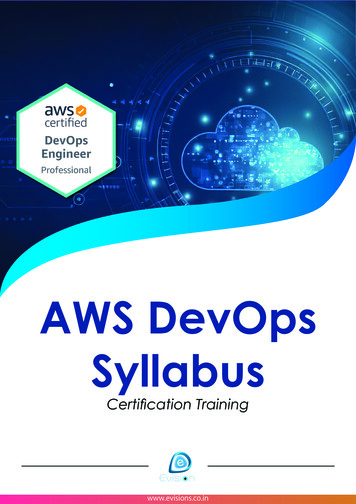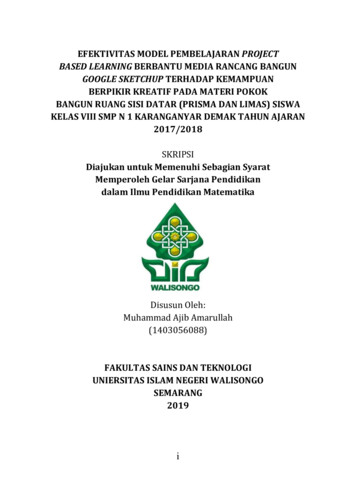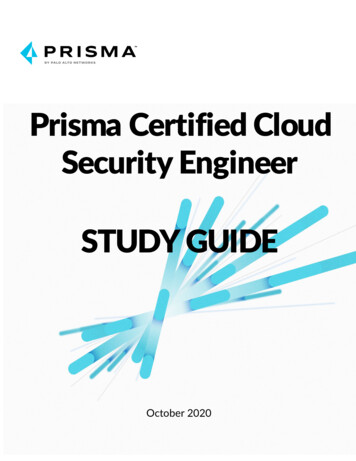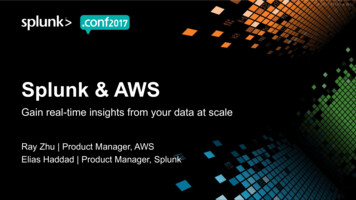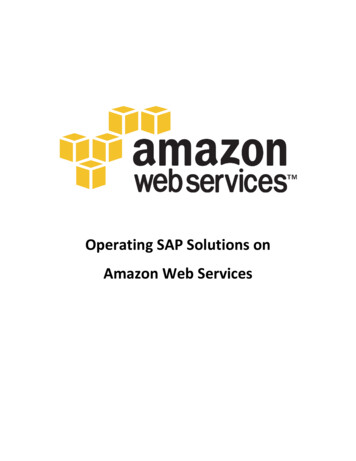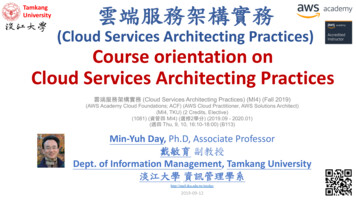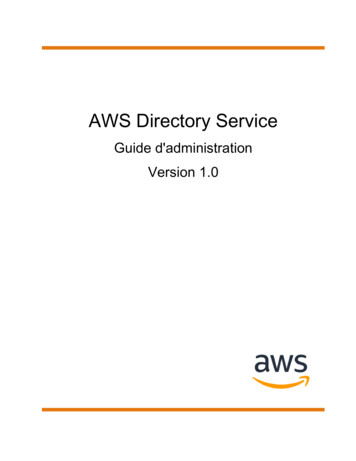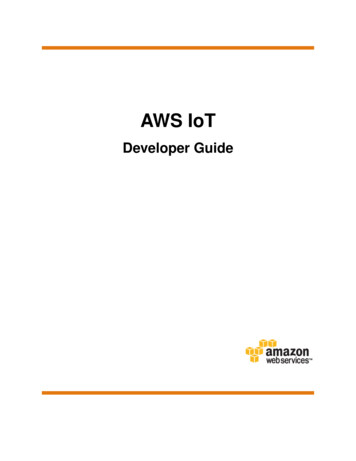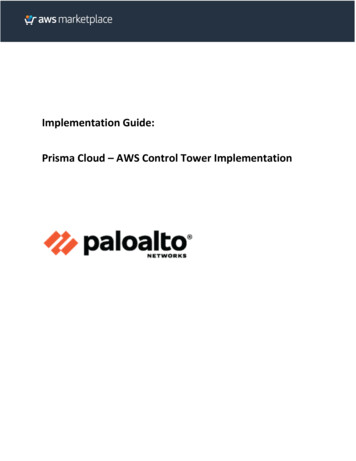
Transcription
Implementation Guide:Prisma Cloud – AWS Control Tower Implementation
Table of ContentsForeword . 3Solution overview and features . 4Prisma Cloud AWS Control Tower Architecture . 4Pre-requisites . 6Best Practices . 13Solution Estimated Pricing . 13Additional resources . 13
ForewordThe Prisma Cloud is a security and compliance service that dynamically discovers cloud resource changesand continuously correlates raw, siloed data sources, including user activity, resource configurations,network traffic, threat intelligence, and vulnerability feeds, to provide a complete view of cloud risk.Through an innovative, machine learning-driven approach, Prisma Cloud enables organizations to quicklyprioritize risks, maintain agile development, and effectively fulfill their obligations in the sharedresponsibility model.The purpose of this AWS Implementation Guide is to enable every AWS Marketplace customer toseamlessly activate, deploy and configure Prisma Cloud in AWS Control Tower environment while takingfull advantage of the resources pre-configured by AWS Control Tower as part of the initialization.
Solution overview and featuresPrisma Cloud unifies Cloud Security Posture Management (CSPM) and Cloud Workload Protection (CWP)into a single cloud native security platform. Continuously monitor your environment and immediatelyenforce governance with hundreds of pre-built policies. Prisma Cloud ingests all major AWS APIs andsources threat intelligence from over 30 feeds including AutoFocus to provide comprehensive visibility.Risk-ranked alerts prevent remediation fatigue and 1-click compliance reporting eases auditing acrosseven the most complex distributed environments. Prisma Cloud also provides full lifecycle security for anycloud native workload or application. It protects applications and the underlying compute resourcesincluding containers and functions by integrating security into AWS CodeDeploy and Elastic ContainerRegistry (ECR) while protecting running workloads and apps. Through this integrated approach onlyPrisma Cloud enables SecOps and DevOps to stay agile, collaborate effectively and securely acceleratecloud native application development and deployment across their entire AWS environment.Benefits of Prisma Cloud on AWS Visualize every connected resource across your AWS environment. Maintain continuous compliance and easily generate reports across your AWS environment. Enable secure DevOps by setting guardrails with real time monitoring for threats, such as riskyconfigurations, sensitive user activities, network intrusions, and host vulnerabilities. Use anomaly detection capabilities to root out account compromises and insider threats. Investigate current threats or past incidents and quickly determine root causes. Get contextual alerts to help your team prioritize issues and respond quickly.Prisma Cloud AWS Control Tower ArchitectureWith consolidated access to AWS services and resources across your company within AWS Organizations, youcan onboard the AWS master account on Prisma Cloud. When enabling the AWS Organizations on the AWSmanagement console and adding the root or master account that has the role of a payer account that isresponsible for paying all charges accrued by the accounts in its organization, all member accounts within thehierarchy are added in one streamlined operation on Prisma Cloud. As a part of the AWS Control Towerexecution first deploy/trigger a CloudFormation template in the master account as a part of the workflow tocreate the Prisma Cloud role to monitor or monitor and protect your resources deployed on the master accountand leverage CloudFormation StackSets to automate the creation of the Prisma Cloud role, which authorizes
Prisma Cloud to access each member account. When a new member account is added to your AWSorganization, it is onboarded automatically on Prisma Cloud. Additionally, as a part of the Control Towerexecution trigger CloudFormation StackSet to allow Lambda Serverless remediation functions to makenecessary changes in the master and member accounts.Figure 1: Prisma Cloud governance on AWS Organization Account: Read Only/ Read Write(The above Figure shows how a new Member Account will be onboarded to Prisma Cloud with eitherReadOnly or ReadWrite Mode automatically once provisioned from AWS Control Tower Environment).
Figure 2: Prisma Cloud governance on AWS Organization Account: Remediation (optional)(The above figure shows the process on how a new AWS member account will be onboarded to PrismaCloud along with Remediation capabilities, this is optional feature, please follow step-11 for moredetails.)Prisma Cloud also integrates with Amazon GuardDuty, AWS Inspector and AWS Security Hub. Prisma Cloudstarts ingesting GuardDuty data, correlates it with the other information that Prisma Cloud alreadycollects, and presents contextualized and actionable information through the Prisma Cloud app, it alsoingests vulnerability data and security best practices deviations from AWS Inspector to provideorganizations with additional context about risks in the cloud and you can also integrate Prisma Cloudwith AWS Security Hub for centralized visibility into security and compliance risks associated with yourcloud assets on the AWS Security Hub console.Pre-requisites Subscribe to Prisma Cloud on AWS B07QDBGS6L?qid 1601399024826&sr 01&ref srh res product title)If you are new to AWS, see Getting Started with AWS (https://aws.amazon.com/getting-started/)For additional information on AWS Marketplace, us?ref footer nav about aws marketplace)
To get started with AWS Control Tower, check out )Deployment and Configuration StepsStep 1: Subscribe to Prisma Cloud on AWS Marketplace.Locate the Prisma Cloud in the AWS Marketplace .Click on the Continue to Subscribe button.Step 2: Deploy Relevant Cloudformation templates: Select the Mode. Decide whether to enable permissions to only monitor (read-only access) or tomonitor and protect (read-write access) the resources in your cloud account. Your selection determineswhich AWS CloudFormation Template (CFT) is used to automate the process of creating the custom rolerequired for Prisma Cloud.Login to Master Account, select Services, CloudFormation, CreateStack, upload one of the belowtemplates as per the deployment mode you choose.Monitor mode: d-only.templateMonitor & Protect mode: d-and-write.template Stack Name —The default name for the stack is PrismaCloudApp.
ExternalID —The Prisma Cloud ID, a randomly generated UUID that is used to enable the trustrelationship in the role's trust policy. Provide a random value like the example shown in template(Ex: - “PrismacloudAWSTest22453”). You will feed in this external-id in Prisma Cloud portal in step6. PrismaCloudRoleName —The name of the role that will be used by Prisma Cloud to authenticateand access the resources in your AWS account, or keep the default Role provided in templateStep 3: Accept the IAM acknowledgment for resource creation and select Create Stack. The stackcreation is initiated. Wait for the CREATE COMPLETE status.Step 4: Select Outputs and copy the value of the PrismaCloudARN. This will be used in step-6. ThePrisma Cloud Role has the permissions required for enabling authentication between Prisma Cloud andyour AWS account.Step 5: Create a StackSet to create the Prisma Cloud role within each member account. AWS StackSetsenables you to automate the process of creating the Prisma Cloud role across multiple accounts in asingle operation.5.a Download the template file. For member accounts with read-only access permissions (Monitor l-read-only-member.templateFor member accounts with the read-write access permissions (Monitor & Protect l-read-and-write-member.template5.b Log in to AWS management account, and choose Services, CloudFormation, StackSets, CreateStackSet.5.c Upload the template file and click Next, then enter a StackSet Name.5.d In Parameters, enter the values for PrismaCloudRoleName and ExternalId.Note: The PrismaCloudRoleName must include Org within the string, Both Rolename andExternalId will be used at later step. Example RoleName – “PrismaCloudOrgMemberReadOnlyRole”Example ExternalID – “PrismacloudAWSTestMemberAccount12345”)5.e Click Next and select Service managed permissions5.f Click Next and select Deploy to organization under Deployment targets.If you do not want to onboard all member accounts, you can select Deploy to organization unit OUsand deploy the Stackset only to selected OUs only.
5.g Set Automatic deployment Enabled, and Account removal behavior Delete stacks.5.h Under Specify regions, select one region. Recommended to keep it same as AWS Control Towerhome region.5.i For Deployment Options, Maximum concurrent accounts, select Percentage and set it to 100.5.j For Deployment Options, Failure tolerance, select Percentage and set it to 100.5.k Click Next, and review the configuration.5.l Select I acknowledge that AWS CloudFormation might create IAM resources with custom namesand SubmitThe StackSet creation is initiated. Wait for the SUCCEEDED status. When the process completes, eachmember account where the role was created is listed under Stack instances on the AWS managementconsole.Step 6: Add a New AWS Organization Account on Prisma Cloud6.a Login to Prisma Cloud, Select Settings, Cloud Accounts, Add New and select AWS as the Cloud toProtect.Note: When Subscribed to marketplace in step-1, You will receive a welcome email from Palo AltoNetworks (noreply@prismacloud.paloaltonetworks.com) that includes a link to where youcan access your instance of Prisma Cloud.6.b Enter a Cloud Account Name and onboard Organization. Log into Prisma Cloud and select Settings, Cloud Accounts, Add New.A cloud account name is auto-populated for you. You can replace it with a cloud account namethat uniquely identifies your AWS Organization on Prisma Cloud.Select the Mode you have choosen in earlier steps for stack deployments.
6.c Configure the master account role details and click Next. (Please use the details copied earlierfrom step-2b and Step-4).6.d Configure the member account role details and click Next.Use the details you copied from the previous step to set up the trust relationship and retrieve datafrom the member accounts. (Please use the details copied earlier from step-5. d.)Note: If you have a large number of member accounts, it may take a while to create the role in eachaccount and list it for verification. If you want to verify that the role was created in all accounts, do notselect the checkbox. You can edit the cloud account settings later and onboard the member accounts.If you do not select the checkbox, only the master account will be onboarded to Prisma Cloud.Select “I confirm the stackset has created Prisma roles in member accounts successfully” and click Next.
6.e Select an “accountgroup” and click Next. Refer to below link for more details on Account groups rators/create-account-groups.htmlDuring initial onboarding, you must assign all the member cloud accounts with the AWS Organizationhierarchy to an account group.Note: If you would like to selectively assign AWS member accounts to different account groups onPrisma Cloud, you can edit the cloud account settings later. We Create an Alert Rule to associate withthat account group so that alerts are generated when a policy violation occurs.6.f Select an account group and click Next.
Step 7: Review the onboarding Status of your AWS Organization on Prisma Cloud.The status check verifies that VPC flow logs are enabled on at least 1 VPC in your master account, andaudit events are available in at least one region on AWS CloudTrail. It also displays the number ofmember accounts that are provisioned with the Prisma Cloud role.Review the info and Select Done.Optional steps to enable remediation:Step 11: Configure the SQS Integration to invoke Lambda based remediationPrisma Cloud can integrate with an SQS queue in the Management Account to sends alert notifications.The SQS can then be used to invoke an AWS Lambda function which would trigger an appropriate runbook script to remediate the alert(s).
Use Case ExampleIf Prisma Cloud finds an S3 bucket does have SSE Encryption turned on it can trigger a lambda basedremediation runbook to enable SSE encryption settings: Reference: dRemediation/blob/master/AWS/lambda package/runbooks/AWS-SSS-014.pyTo Configure the SQS integration follow the steps ith-amazon-sqs.html)Use the following CFT Templates to create an IAM role for Lambda Based s)The complete Lambda package and list of runbooks is available nhancedRemediation/tree/master/AWS/lambda package)Best Practices Follow the Prisma Cloud Administration Best Practices inistrators.htmlSolution Estimated PricingAnnual: - YG: - id 1601399503056&sr 02&ref srh res product titleAdditional resources Prisma Cloud Admin aws-organization-to-prisma-cloud.html Partner contact y/contact-support
Note: When Subscribed to marketplace in step-1, You will receive a welcome email from Palo Alto Networks noreply@prismacloud.paloaltonetworks.com( ) that includes a link to where you can access your instance of Prisma Cloud . 6.b Enter a Cloud Account Name and onboard Organization. Log into Prisma Cloud and select

